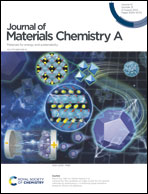Origin of enhanced reversible Na ion storage in hard carbon anodes through p-type molecular doping†
Abstract
Na-ion batteries (SIBs) require novel anode materials which have high ion storage capability and low working voltage to make SIBs competitive compared to Li-ion batteries (LIBs). From this perspective, we present the origin of improved electrochemical performances of phosphate doped hard carbon (P-HC) which can meet the two requirements mentioned above through combining experiment with the calculations of atomic/electronic structures. We disclosed that the capacity enhancement is accompanied by the changed voltage profile, which results from the introduced phosphate functional groups. The emerged redox peak turned out to be generated by the electrochemical reaction of Na ions near the phosphate-carbon environment. First-principles calculations elaborated that the phosphate introduction here generates electron holes near the Fermi level that is generally considered as evidence of p-type semiconductors to improve electronic conductivity. This expectation has been proven by comparatively measuring the electrical conductivities of pristine hard carbon and P-HC. A close investigation into charge distribution indicated that the electron hole is generated mainly by the higher reducibility of the doped phosphate than the surrounding carbon atoms in P-HC. This discovery well explains the underlying principles for the enhanced electrochemical performance of P-HC, thereby showing a way to design highly functional hard carbon structures toward higher capacity with Na ions.



 Please wait while we load your content...
Please wait while we load your content...